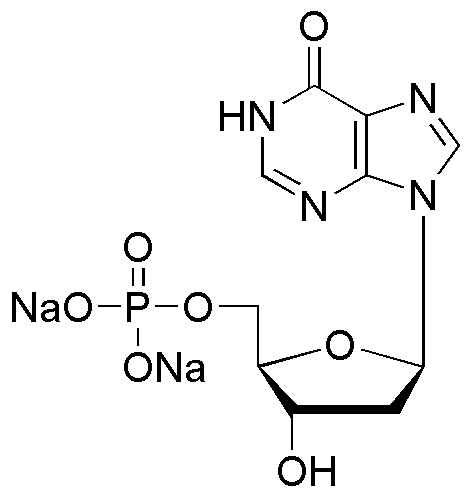2'-Deoxyinosine-5'-monophosphate disodium salt is widely utilized in research focused on:
- Nucleotide Synthesis: This compound serves as a key building block in the synthesis of nucleotides, which are essential for DNA and RNA production. Researchers in molecular biology and genetics often use it to study gene expression and replication.
- Biochemical Assays: It is commonly employed in various biochemical assays to measure enzyme activity related to nucleotide metabolism. This application is crucial for drug discovery and understanding metabolic pathways.
- Pharmaceutical Development: The compound plays a role in developing antiviral and anticancer drugs by acting as a substrate for enzymes involved in nucleic acid synthesis, providing a pathway for therapeutic interventions.
- Cell Culture Studies: In cell culture, it is used to supplement growth media, enhancing the proliferation of cells that require specific nucleotides for optimal growth, particularly in research on stem cells and cancer.
- Genetic Engineering: This chemical is instrumental in genetic engineering applications, such as CRISPR technology, where it aids in the precise editing of genetic material, allowing for advancements in biotechnology and medicine.
General Information
Properties
Safety and Regulations
Applications
2'-Deoxyinosine-5'-monophosphate disodium salt is widely utilized in research focused on:
- Nucleotide Synthesis: This compound serves as a key building block in the synthesis of nucleotides, which are essential for DNA and RNA production. Researchers in molecular biology and genetics often use it to study gene expression and replication.
- Biochemical Assays: It is commonly employed in various biochemical assays to measure enzyme activity related to nucleotide metabolism. This application is crucial for drug discovery and understanding metabolic pathways.
- Pharmaceutical Development: The compound plays a role in developing antiviral and anticancer drugs by acting as a substrate for enzymes involved in nucleic acid synthesis, providing a pathway for therapeutic interventions.
- Cell Culture Studies: In cell culture, it is used to supplement growth media, enhancing the proliferation of cells that require specific nucleotides for optimal growth, particularly in research on stem cells and cancer.
- Genetic Engineering: This chemical is instrumental in genetic engineering applications, such as CRISPR technology, where it aids in the precise editing of genetic material, allowing for advancements in biotechnology and medicine.
Documents
Safety Data Sheets (SDS)
The SDS provides comprehensive safety information on handling, storage, and disposal of the product.
Product Specification (PS)
The PS provides a comprehensive breakdown of the product’s properties, including chemical composition, physical state, purity, and storage requirements. It also details acceptable quality ranges and the product's intended applications.
Certificates of Analysis (COA)
Search for Certificates of Analysis (COA) by entering the products Lot Number. Lot and Batch Numbers can be found on a product’s label following the words ‘Lot’ or ‘Batch’.
Número de catálogo
Número de lote/lote
Certificates Of Origin (COO)
This COO confirms the country where the product was manufactured, and also details the materials and components used in it and whether it is derived from natural, synthetic, or other specific sources. This certificate may be required for customs, trade, and regulatory compliance.
Número de catálogo
Número de lote/lote
Safety Data Sheets (SDS)
The SDS provides comprehensive safety information on handling, storage, and disposal of the product.
DownloadProduct Specification (PS)
The PS provides a comprehensive breakdown of the product’s properties, including chemical composition, physical state, purity, and storage requirements. It also details acceptable quality ranges and the product's intended applications.
DownloadCertificates of Analysis (COA)
Search for Certificates of Analysis (COA) by entering the products Lot Number. Lot and Batch Numbers can be found on a product’s label following the words ‘Lot’ or ‘Batch’.
Número de catálogo
Número de lote/lote
Certificates Of Origin (COO)
This COO confirms the country where the product was manufactured, and also details the materials and components used in it and whether it is derived from natural, synthetic, or other specific sources. This certificate may be required for customs, trade, and regulatory compliance.


